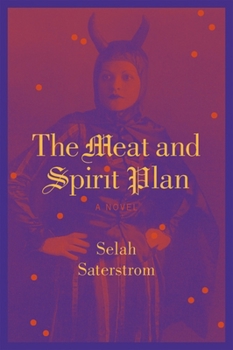The Meat and Spirit Plan
Select Format
Select Condition 
Book Overview
A searing coming-of-age novel set to the music of chance.
Format:Paperback
Language:English
ISBN:1566892015
ISBN13:9781566892018
Release Date:September 2007
Publisher:Coffee House Press
Length:240 Pages
Weight:0.60 lbs.
Dimensions:0.7" x 5.0" x 7.5"
Customer Reviews
4 ratings
Who Do Voodoo?
Published by Thriftbooks.com User , 15 years ago
I picked this up last night and couldn't put it down, subconsciously compelled to read this amazing book from cover to cover in one sitting. Using compact, witty, and cathartic vignettes, Saterstrom transports the reader into the heart and mind of the nameless narrator, where the female heroine exposes her darkest secrets as if it's a ritual, a rite of passage, as we follow her through childhood to early adulthood. The succession of scenes act as snapshots, the flashbulbs exploding in the mind leaving the reader in awe.
A Wry Celebration of Disparity
Published by Thriftbooks.com User , 15 years ago
This text embraces the coming-of-age story and takes it into new territory. Growing up is not just about finding the self, but it is about establishing a relationship between the "meat" and the "spirit," or in other words, about resolving the mind/body problem: trying to create a sense of a unified and whole entity, while the body is changing and the mind (spirit) is changing. This text is about process, and to evaluate this process, it steps outside the subject to look through and at the subject, but still from the position of the subject. It is an objective look at subjectivity in first person point-of-view. Perhaps it represents the confusion and disassociation that result from trauma. Coming-of-age is shown here as psychological trauma--and the body/mind separation that results. The subject becomes a witness, removed into a safer place, a place without feeling. The section titles say something in themselves: "Headbanger's Ball" juxtaposed with "Religious Studies," then "The Slaughterhouses of Glasgow," "Magic Tricks for a Hospital Setting," and "The Life of Ginger Rogers, by Ginger Rogers." Why the heavy-metal chapter titles? Maybe something about the rawness of the narrator's early life experience. And the violence. Clashing against everything, and needing to scream, but being unable to, so doing it vicariously through music. Catharsis. The titles correspond with her action, "I incised some narrow lines into my palms and between my fingers" (43). The separate passages--the fragmented nature of the form this text is presented to us in--this represents memory. It resembles recollections told to a therapist over a period of time--or a journal written after the fact, maybe. The "Religious Studies" section illustrates an attempt at college life. She is in a period of seeking, and immersed in an institution. The highly-structured environment may not work for her in a long-term way, but it has opened her into a new awareness, perhaps, at least in some small way. "The Slaughterhouses of Glasgow" shows her expanding out into a multi-cultural world. A certain violence still pervades this section, but it is not only matter-of-fact, like earlier in the book, but maybe even wry, humorous, or even slightly celebratory of the disparity she again finds herself immersed in. Instead of music, she finds expression in art, and sits in front of it, rather than talk or write her thesis: "Then I sit in front of it when I'm supposed to be at University library writing my research thesis" (143-144). A slaughtered ox that represents so much for her--this metaphor is so colourful. "Magic Tricks for a Hospital Setting" transitions the narrator into a space of healing. She must look at her problems of metabolising/digesting her past. "The Life of Ginger Rogers, by Ginger Rogers" projects her experience into a setting of film. She becomes the film star--her only name in the book--and a surreal art film with a multi-cultural cast brings tog
A moving work of literary art
Published by Thriftbooks.com User , 15 years ago
This review is more or less random notes I took while reading, presented in no particular order... Saterstrom's work gets its power from metaphoric imagery as well as sentences whose rhythms embody, enliven, content, such as the forward-crash of the first line on page 90 which starts a new episode, as if the novel is taking a gasp of resurrecting air after the narrator's mom admits she's gone back to coke. This novel shows its author's attention to theme-plot and place (Beau Repose, Mississippi) and models the act of writing as a kind of (ancient) way of knowing. This work startles with its poetic clarity and intuitive strangeness of episode endings. Metaphors, especially those on pages 16, 18, and 99, enliven already powerful prose. Moments of insight, such as on page 130 that, for the narrator, "[faith] could be impure...", and other sections that are stream-of-consciousness-like, such as the thought spiral on page 24, are very enjoyable. Portentous imagery also appears, fueling theme-plot and diversions through imagery. The Geronimo section on 80 and Aztec song on 87 are nice. It made me wonder, though, where the character Jude had gone. I wished he would make a haunting reappearance. Overall, a very excellent work by a very capable writer. Highly recommended. Justin Nicholes Fiction Editor, Our Stories
the bright future of southern literature
Published by Thriftbooks.com User , 17 years ago
Saterstrom's work, including her debut novel THE PINK INSTITUTION, is the finest work by a contemporary American writer that I have come across in quite awhile. Following in the strong Southern tradition of exceptional literature (William Faulkner, Flannery O'Connor, John Kennedy Toole) Saterstrom writes of a broken society struggling to rise from the ashes of its violent history, a society battling its overwhelming decay. Just as these traditions of extreme violence and decay persist, so does the individual voice of those who fight for a better life; the question is, who will win the battle?





